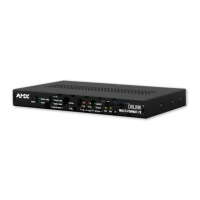Appendix B – Telnet (Terminal) Commands
119
Instruction Manual – DXLink™ Twisted Pair Transmitters/Receiver
Master Connection Modes
The mode of communication used for connection to the Master is specified via the SET CONNECTION
Telnet command (see page 116).
Connection mode setting options are AUTO, TCP URL, UDP URL, or NDP (default) as described:
AUTO – This mode utilizes TCP communication. It looks for a matching System Number and
attempts to come online with the first Master it sees with that System Number.
TCP URL – TCP; the Master is specified via URL.
UDP URL – UDP; the Master is specified via URL.
NDP – UDP; this mode utilizes the NDP binding process to assign the DXLink Module (the
physical device) to a Master (or Virtual Master) via NetLinx Studio. Once bound,
communications are conducted via UDP.
Note: In URL modes, the Master can use either an IP address or a DNS name.
TCP vs. UDP
TCP – Protocol has a built-in retry mechanism.
UDP – Protocol does not have a built-in retry mechanism, but consumes fewer resources on
the Master. AMX’s UDP implementation of NetLinx employs a retry mechanism to provide
the reliability of TCP with the resource efficiency of UDP.
URL vs. NDP vs. Auto
Determining which connection method to use for Master Connection Mode is essentially a matter of
deciding what information the device should use to identify the correct Master to connect to.
The default mode is NDP; the mode can be changed via the SET CONNECTION Telnet command (see
page 116).
URL – The device connects to the Master with the specified URL. The device must be
configured with the URL of a specific Master via the SET CONNECTION Telnet command
(see page 116).
NDP – The device connects to the Master it’s been bound to, which is based on the Master’s
MAC address. The binding is configured via NetLinx Studio. Once bound, the device must be
unbound using either NetLinx Studio or the Telnet NDP UNBIND command before being
re-bound to a different Master.
Alternatively, NDP devices can be bound/unbound via options on the Master’s Web
Configuration pages (System > Manage NetLinx). For details, refer to the NetLinx Integrated
Controllers - WebConsole & Programming Guide (System - Manage NetLinx section).
Auto – The device connects to the first Master it finds with the specified System Number.
The device must be configured with the desired system number via the SET CONNECTION
Telnet command (see page 116).
Use of this method requires that only one Master has any particular system number and is
visible to the subnet. If this is the case, then Auto is the simplest choice. However, with Auto,
you are not hard-bound to a particular Master. Therefore, if at some point in the future,
another Master is configured with the same system number, the result is that the DXLink
Module could show up on that other Master.

